| |
|
|
|
5
Detroit
Civil
Rights
sites
listed
in the
National
Register
of
Historic
Places
•
Designation
recognizes
Detroit’s
significant
role in
growth
of Civil
Rights
Movement
• New
listings
are
Birwood
Wall,
New
Bethel
Baptist
Church,
Rosa L.
and
Raymond
Parks
Flat,
Shrine
of the
Black
Madonna
of the
Pan
African
Orthodox
Christian
Church,
WGPR-TV
Studio
LANSING,
Mich. –
Five
historic
Detroit
places
associated
with the
Civil
Rights
Movement
and
African
American
experience
in the
twentieth
century
have
been
recognized
by the
National
Park
Service
(NPS),
the
Michigan
Economic
Development
Corporation
announced
today.
Nominated
by
Michigan’s
State
Historic
Preservation
Office
(SHPO),
these
five
sites
join
nearly
2,000
others
in the
state
that
have
been
listed
in the
National
Register
of
Historic
Places
since
1966.
“These
places
are
associated
with
both the
struggles
and
successes
of the
African
American
community
in
Detroit
during
the
volatile
mid-twentieth
century.
The
Civil
Rights
Movement
sought
to
demand
equality
for
African
Americans
in the
North as
much as
in the
South,”
said
Deputy
State
Historic
Preservation
Officer
Martha
MacFarlane-Faes.
“By
listing
these
sites,
the
National
Register
recognizes
Detroit’s
significant
role in
the
growth
of the
movement.
They
embody
the wide
range of
issues
the
Black
community
encountered
as it
worked
toward
empowerment
during
this
period.”
The
nominations
to the
National
Register
were
prepared
as a
part of
a
competitive
African
American
Civil
Rights
program
grant
awarded
by NPS
to the
Michigan
SHPO.
The
sites
were
selected
by a
14-person
Civil
Rights
Advisory
Committee
that
included
local
historians
familiar
with
Detroit’s
Black
history
and
staff
members
from
SHPO and
City of
Detroit
Historic
Designation
Advisory
Board.
Quinn
Evans
Architects
of Ann
Arbor
was
selected
to
research
and
prepare
the
nominations
for each
of the
five
sites
along
with a
context
document
that
more
broadly
discusses
the
Civil
Rights
Movement
in
Detroit
throughout
the
twentieth
century.
The
Civil
Rights
sites in
Detroit
that
were
listed
in the
National
Register
are:
•
Birwood
Wall,
located
along
the
alleyway
between
Birwood
Avenue
and
Mendota
Street
from
Eight
Mile
Road to
Pembroke
Avenue
• New
Bethel
Baptist
Church,
8430
Linwood
Street
• Rosa
L. and
Raymond
Parks
Flat,
3201-3203
Virginia
Park
Street
(private
residence)
• Shrine
of the
Black
Madonna
of the
Pan
African
Orthodox
Christian
Church,
7625
Linwood
Street
•
WGPR-TV
Studio,
3146
East
Jefferson
Avenue
“On
behalf
of the
officers
and
members
of the
Shrine
of the
Black
Madonna
in
Detroit,
Atlanta,
Houston,
Calhoun
Falls,
S.C.
Monrovia
and
Ganta
City,
Liberia
we are
honored
to
receive
this
national
historical
landmark
designation,”
said
Shrine
of the
Black
Madonna
Bishop
Mbiyu
Chui.
“We
continue
to build
and
expand
upon the
legacy
of our
beloved
founder,
Rev.
Albert
B.
Cleage
Jr. who
devoted
his life
and
ministry
to the
mission
of
transforming
urban
ghettoes
into
Christian
communities
to bring
about
equality,
justice
and
freedom
for his
people
at home
and
abroad.”
To be
considered
for
National
Register
listing,
a
property
must be
at least
50 years
old,
possess
historic
integrity,
and be
significant
for its
association
with
important
people,
events,
or
architecture/design
at the
local,
state,
or
national
level.
Birwood
Wall

The
Birwood
Wall is
significant
for its
association
with the
federal
policy
of
redlining
that
ensured
neighborhoods
would
remain
racially
segregated
in the
mid-twentieth
century.
The wall
is a
six-foot-high
solid
concrete
wall
that
stretches
for
three
blocks.
It was
constructed
in 1941
to
physically
divide
two
growing
neighborhoods,
one
White
and one
Black.
It is a
rare
surviving,
tangible,
human-scale
example
of the
lengths
to which
the
government,
the real
estate
profession,
private
developers,
and
White
residents
were
willing
to go to
keep
neighborhood
populations
the same
race.
Redlining
meant
African
Americans
rarely
qualified
for
federal
mortgage
loans
and thus
were
denied
participation
in the
American
Dream of
homeownership
that
characterized
the
postwar
era. The
wall can
be
publicly
viewed
from the
Alfonso
Wells
Memorial
Playground.
New
Bethel
Baptist
Church

New
Bethel
Baptist
Church
is
significant
for its
association
with the
Reverend
C. L.
Franklin
and the
extensive
leadership
the
church
showed
during
in the
Civil
Rights
Movement
in the
1960s.
Franklin
was a
gifted
and
influential
pastor
whose
radio
show and
recordings
attained
a
national
following.
He was a
supporter
of the
non-violent
activism
of Dr.
Martin
Luther
King Jr.
and was
the
originator
of the
Walk to
Freedom
march
held in
Detroit
in 1963,
the
first
major
civil
rights
march in
the
nation’s
history.
New
Bethel
Baptist
Church
it is
also the
venue
where
singer
Aretha
Franklin
began
her
musical
career.
Rosa L.
(McCauley)
and
Raymond
Parks
Flat

When
Rosa
Parks
refused
to give
up her
bus seat
to a
White
passenger
in
Montgomery,
Alabama
in 1955,
she
changed
the
course
of civil
rights
history
and
focused
national
attention
on
discriminatory
practices.
To
escape
the
harassment
she
faced in
Alabama,
Parks
and her
husband
Raymond
moved
north
eventually
settling
in
Detroit,
where
she had
family.
They
moved
into the
ground
floor
flat of
this
duplex
in 1961
and
lived
there
until
1988.
During
this
time,
Parks
continued
her
activism
and the
flat
became a
place
for
meetings
and
discussions
on civil
rights.
She
served
as an
aid to
Congressman
John
Conyers
Jr. and
participated
in
numerous
civil
rights
events
while
advocating
for
equal
treatment
under
the law
for
African
Americans
around
the
country.
In the
late
1960s
she
aligned
with
Detroit’s
leaders
in the
Black
Power
Movement.
Parks
took a
particular
interest
in
children
and
developed
the Rosa
and
Raymond
Parks
Institute
for Self
Development
in 1987
to
further
youth
education
and
leadership.
(NOTE:
this
property
remains
a
private
residence.)
Shrine
of the
Black
Madonna
of the
Pan
African
Orthodox
Christian
Church

Commonly
known as
the
Shrine
of the
Black
Madonna,
this
church
is
significant
for its
association
with the
Reverend
Albert
B.
Cleage
Jr.
(later
Jaramogi
Abebe
Agyeman).
Cleage
was a
nationally
known
civil
rights
leader,
a
champion
of the
Black
Nationalism
Movement,
and a
fiery
community
organizer
in
Detroit.
He
advocated
for
unity
among
African
Americans,
and
championed
separatism
over
integration.
Cleage
believed
Blacks
should
actively
develop
their
own
power
structures,
instead
of
waiting
for
traditional
White
society
to hand
them
their
rights.
On
Easter
Sunday
1967,
Cleage
shocked
the
Black
community
when he
rechristened
Central
Congregational
Church
as the
Shrine
of the
Black
Madonna,
and
unveiled
an
18-foot
mural of
a Black
Madonna
and
child
commissioned
from
Black
artist
Glanton
Dowdell,
challenging
Blacks
to adopt
a new
world
view
that was
not
based on
accepted
White
norms.
The
Shrine
became
one of
the
largest
and most
influential
Black
Nationalist
churches
in the
country
and the
mural an
iconic
symbol
of the
Civil
Rights
Movement.
WGPR-TV
Studio

WGPR-TV
is
significant
as the
first
Black-owned
and
operated
television
station
in the
United
States.
Founded
by
attorney
William
R.
Banks,
the
station
debuted
in
September
1975, a
decade
after
African
Americans
challenged
the FCC
on the
lack of
Black
programming.
WGPR-TV
aired an
Afro-centric
focused
newscast,
a dance
show,
and
public
affairs
features.
In
addition
to
providing
an
African
American
perspective
on news
and
current
affairs,
it also
afforded
career
and
training
opportunities
behind
the
camera
for
Black
students
and
professionals.
The
station
was
eventually
sold to
CBS in
1995
when it
transitioned
to
general
programming
and
changed
its call
sign to
WWJ. The
interior
studio
space
retains
a high
degree
of
integrity
from the
WGPR-TV
television
station
era. It
has
since
been
transformed
into the
William
V. Banks
Broadcast
Museum
which
chronicles
the
origins
and
influence
of WGPR.
The
National
Register
is the
United
States
federal
government's
official
list of
districts,
sites,
buildings,
structures,
and
objects
deemed
worthy
of
preservation
for
their
historical
significance.
Properties
are
nominated
for
listing
by each
state’s
SHPO,
often in
partnership
with
local
individuals
or
community
organizations.
Focused
on the
historic
preservation
of
culturally
or
archaeologically
significant
sites
throughout
the
state,
Michigan's
State
Historic
Preservation
Office’s
main
function
is to
provide
technical
assistance
to local
communities
and
property
owners
in their
efforts
to
identify,
evaluate,
designate,
interpret
and
protect
Michigan’s
historic
above-
and
below-ground
resources.
SHPO
also
administers
an
incentives
program
that
includes
federal
tax
credits
and
pass-through
grants
available
to
certified
local
governments.
For
more
information
about
the
National
Register
of
Historic
Places
program
in
Michigan,
and on
how to
nominate
a
property,
visit
https://www.miplace.org/historic-preservation/programs-and-services/national-register-of-historic-places/
For more
information
about
the
African
American
Civil
Rights
program
grant
awarded
to the
Michigan
SHPO and
for
links to
the
National
Register
nominations
for each
of these
Civil
Rights
sites,
visit
https://www.miplace.org/historic-preservation/programs-and-services/detroit-civil-rights-project/
Advertise With Us:

Certified Minority Business Enterprise

|
| |
|
|
|
|
|